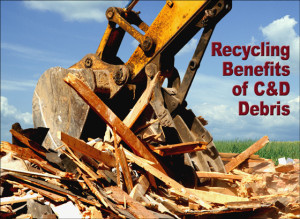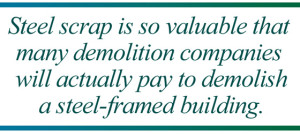The Benefits of Recycling and Reusing C&D Waste
Researching construction and demolition debris makes me think of the animated movie “WALL·E.”
 In the movie, the world was overrun with garbage. The people abandoned the Earth in luxury spaceships, leaving automated robots to clean up the planet. Seven hundred years later, only the little robot WALL·E remained functioning, diligently crushing trash into cubic foot squares stacked as high as skyscrapers.
In the movie, the world was overrun with garbage. The people abandoned the Earth in luxury spaceships, leaving automated robots to clean up the planet. Seven hundred years later, only the little robot WALL·E remained functioning, diligently crushing trash into cubic foot squares stacked as high as skyscrapers.
Every movie has a hero. The intrepid little rusty robot is the hero in “WALL·E.” Recycling is the hero in the environmental movement.
Why Recycling C&D Waste Matters
Every item salvaged from construction and demolition (C&D) debris for recycling helps in five basic ways:
- Reducing the sheer volume of debris dumped in landfills or burned.
- Conserving raw materials needed to recreate the building material.
- Decreasing the environmental impacts, greenhouse emissions, water waste, and energy required to extract and manufacture virgin building materials.
- Creating 19,000 jobs. C&D recycling boosts the economy with $7.4 billion in annual revenues.
- Saving money on building projects by buying recycled products and controlling disposal costs— and reaping the benefits of green building certifications, rebates, and tax credits where applicable.
Steel: The Hero of C&D Recycling
According to “C&D World,” 70% of construction and demolition debris is now recycled. The Environmental Protection Agency (EPA) says only 40% of C&D material was recycled just 12 years ago.
Materials recycled at building sites typically include asphalt, cardboard and packaging materials, concrete, lumber, metals like steel, pavement (from parking lots), roofing materials, and wallboard.
Most building materials are down-cycled into less significant products. For example, wood is chipped up for mulch and concrete is ground for use as a road base.
 Steel, however, recycles easily into more high-quality steel.
Steel, however, recycles easily into more high-quality steel.
New technologies have improved the strength of steel. Today’s steel is 30% stronger than steel produced a decade ago. Consequently, steel from older buildings recycled today creates new steel actually stronger than the original!
More steel is recycled than any other building material. As much as 99% of a steel building can be recycled or reused.
There is a ready-made market for steel scrap. According to the American Institute of Steel Construction (AISC), steel scrap is so valuable that many demolition companies will actually pay to demolish a steel-framed building. Structures built with other materials may cost $3-$10 per square foot to demolish and transport to a landfill.
Efficient, Economical, and Eco-Friendly RHINO Steel Buildings
RHINO’s red-iron steel buildings construct the greenest structures on the planet. Our buildings are designed to create the strongest building with the least amount of steel, producing the most bang-for-the-buck.
Call us at 940.383.9566 for details about our long-lasting, environmentally –friendly steel buildings. Get a free quote on your next construction project.
